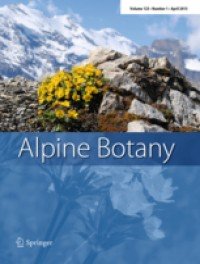Alpine Botany Q1 Unclaimed
Alpine Botany is an international journal providing a forum for plant science studies at high elevation with links to fungal and microbial ecology, including vegetation and flora of mountain regions worldwide. Alpine Botany publishes original contributions and reviews on biogeography, biosystematics, evolutionary biology, population biology, ecophysiology, functional ecology of vegetation, flora as well as symbiotic associations. We also welcome studies on fungi, mosses and lichens and plant-animal interactions. We aim at contributions that explore plant biological phenomena in order to understand functionally. It has an SJR impact factor of 0,82.
Type: Journal
Type of Copyright:
Languages: English
Open Access Policy: Open Choice
Type of publications:
Publication frecuency: -
3060 €
Inmediate OANPD
Embargoed OA0 €
Non OAMetrics
0,82
SJR Impact factor36
H Index20
Total Docs (Last Year)57
Total Docs (3 years)1380
Total Refs163
Total Cites (3 years)57
Citable Docs (3 years)2.41
Cites/Doc (2 years)69.0
Ref/DocOther journals with similar parameters
Annual Review of Plant Biology Q1
Fungal Diversity Q1
Molecular Plant Q1
Nature Plants Q1
Annual Review of Phytopathology Q1
Compare this journals
Aims and Scope
Best articles by citations
A definition of mountains and their bioclimatic belts for global comparisons of biodiversity data
A climate-based model to predict potential treeline position around the globe
A global inventory of mountains for bio-geographical applications
Plant invasions into mountains and alpine ecosystems: current status and future challenges
Specific leaf area correlates with temperature: new evidence of trait variation at the population, species and community levels
1914–2014: A revised worldwide catalogue of cushion plants 100 years after Hauri and Schröter
Species richness, endemism and species composition in the tropical Afroalpine flora
Precipitation and species composition primarily determine the diversity–productivity relationship of alpine grasslands on the Northern Tibetan Plateau
Climatic drivers of plant–plant interactions and diversity in alpine communities
Thermal imaging reveals massive heat accumulation in flowers across a broad spectrum of alpine taxa
Factors influencing altitudinal patterns of C3 plant foliar carbon isotope composition of grasslands on the Qinghai-Tibet Plateau, China
Plant traits across different habitats of the Italian Alps: a comparative analysis between native and alien species
Working toward integrated models of alpine plant distribution
Elevation matters: contrasting effects of climate change on the vegetation development at different elevations in the Bavarian Alps
Current vegetation changes in an alpine late snowbed community in the south-eastern Alps (N-Italy)
Multiple mycorrhization at the coldest place known for Angiosperm plant life
Plasticity of flower longevity in alpine plants is increased in populations from high elevation compared to low elevation populations
Diversity, distribution, ecology and description rates of alpine endemic plant species from Iranian mountains
Seeds at risk: How will a changing alpine climate affect regeneration from seeds in alpine areas?
A resurvey of late-lying snowpatches reveals changes in both species and functional composition across snowmelt zones
A bioclimatic characterization of high elevation habitats in the Alborz mountains of Iran
Phylogeographic patterns of highland and lowland plant species in Japan
Estimating herbaceous plant biomass in mountain grasslands: a comparative study using three different methods



Comments